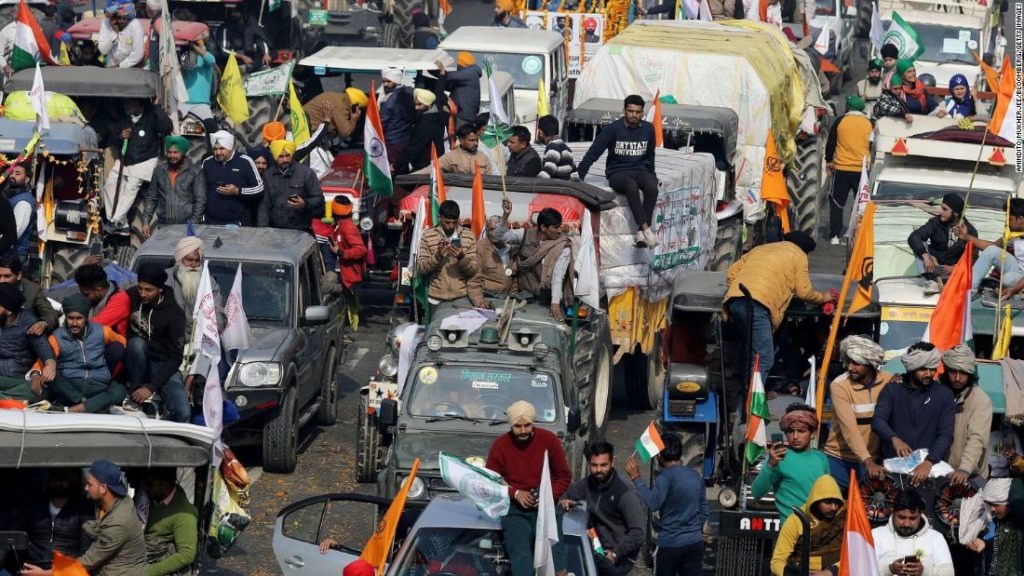Tear gas and flash bangs could been seen on live streams from the city’s streets as police moved to contain large crowds of protestors in tractors and on foot from breaking through barricades. Both police and protesters were spotted with large sticks in the streets.
Many of the farmers, who had adorned their tractors with colorful flags, including the flag of India and various farmers unions, had been camping out in protest on the outskirts of the capital for more than two months. Others, including young farmers from the northern states of Haryana, Uttar Pradesh, Punjab and Rajasthan, had gathered on the border over the past few days in time for the planned march on India’s Republic Day.
Police used tear gas and batons against protesters outside Delhi police headquarters and at two bordering areas of the city as some farmers broke through barricades, protesters said Tuesday.
“Outside the Delhi police headquarters tear gas and batons were used, protestors also attacked the police buses stationed there,” said Paramjeet Singh Katyal, a spokesperson for Samyukt Kisan Morcha, the umbrella group representing farmers’ unions.
“We have broken the barricades, we have our tractors, people are marching, some leaders are also on horseback… thousands of farmers have already reached the capital,” Katyal said.
Samyukt Kisan Morcha later called off the march in a statement, and denounced the “anti-social elements” which had “infiltrated the otherwise peaceful movement.”
The statement thanked farmers for their “unprecedented participation” in Tuesday’s event, but expressed regret over the “undesirable and unacceptable events that have taken place today” and dissociated the group from “those indulging in such acts.”
At the Ghazipur border between Delhi and Uttar Pradesh, police used tear gas and batons to push back about 2,000 protesters, and tear gas was also used at the Singhu border between Delhi and Haryana on Tuesday morning, according to Ashutosh Mishra, a spokesperson for All India Sangharsh Coordination Committee, one of the unions leading the protests.
Although the police had given permission for farmers to hold a tractor rally in Delhi, they had placed a cap of 5,000 tractors, according to Mishra. However more than 200,000 tractors were mobilized, with many young people coming from neighboring states, said Darshan Pal, president of Krantikari Kisan Union, one of several leading the protests.
Delhi police spokesman Eish Singha said that officers had “showed a lot of restraint till the end but agitators defied the conditions and started their march before the scheduled time, and chose the path of violence and sabotage.”
Singha added that in view of this it was necessary for Delhi Police to “maintain law and order,” adding that the clashes had damaged property and injured a number of police personnel.
For decades, the Indian government offered guaranteed prices to farmers for certain crops, providing long-term certainty that, in theory, allowed them to make investments for the next crop cycle. The new agricultural laws, first passed in September by Modi’s government, instead allow farmers to sell their goods to anyone for any price — giving them more freedom to do things such as sell directly to buyers and sell to other states.
But farmers argued that the new rules would leave them worse off by making it easier for corporations to exploit agricultural workers, and help big companies drive down prices. While farmers could sell crops at elevated prices if the demand is there, conversely, they could struggle to meet the minimum price in years when there is too much supply in the market.
The laws have been so contentious because agriculture is the primary source of livelihood for about 58% of India’s 1.3 billion population, and farmers have been arguing for years to get the minimum guaranteed prices increased. They are the biggest voter block in the country — making farming a central political issue.
There have been sit-ins lasting days along each of New Delhi’s three borders. Farmers have blocked roads and set up makeshift camps, some sleeping on the road or in their tractors. They arrived from numerous different states to participate in the mass protests, at times clashing with police.
The government has held 11 rounds of talks with leaders of more than 30 farmers’ unions that are opposed to the laws — but the talks have gone nowhere.
Increasing the pressure, protesters on Tuesday said as well as the three routes into the city designated by Delhi police, they intended to march at six points on the city’s borders as well as in the northern states of Haryana, Rajasthan and Uttar Pradesh, according to Yogendra Yadav, a leader of the farmers’ protests.
Farmers’ unions also plan to march to parliament on February 1, the day that the parliament will hold its budget session, Yadav said.
To control the crowd, Delhi traffic police have created diversions along several major highways and main roads in city and the metro has shut exits at least 15 stations close to protest sites.
You may also like
-
UK coronavirus variant has been reported in 86 countries, WHO says
-
NASA technology can help save whale sharks says Australian marine biologist and ECOCEAN founder, Brad Norman
-
California Twentynine Palms: Explosives are missing from the nation’s largest Marine Corps base and an investigation is underway
-
Trump unhappy with his impeachment attorney’s performance, sources say
-
Lunar New Year 2021: Ushering in the Year of the Ox

